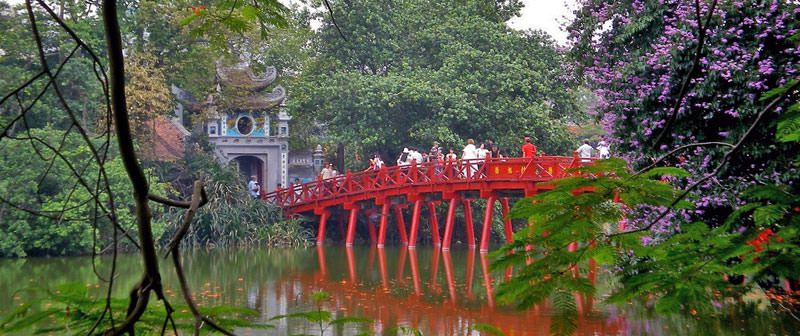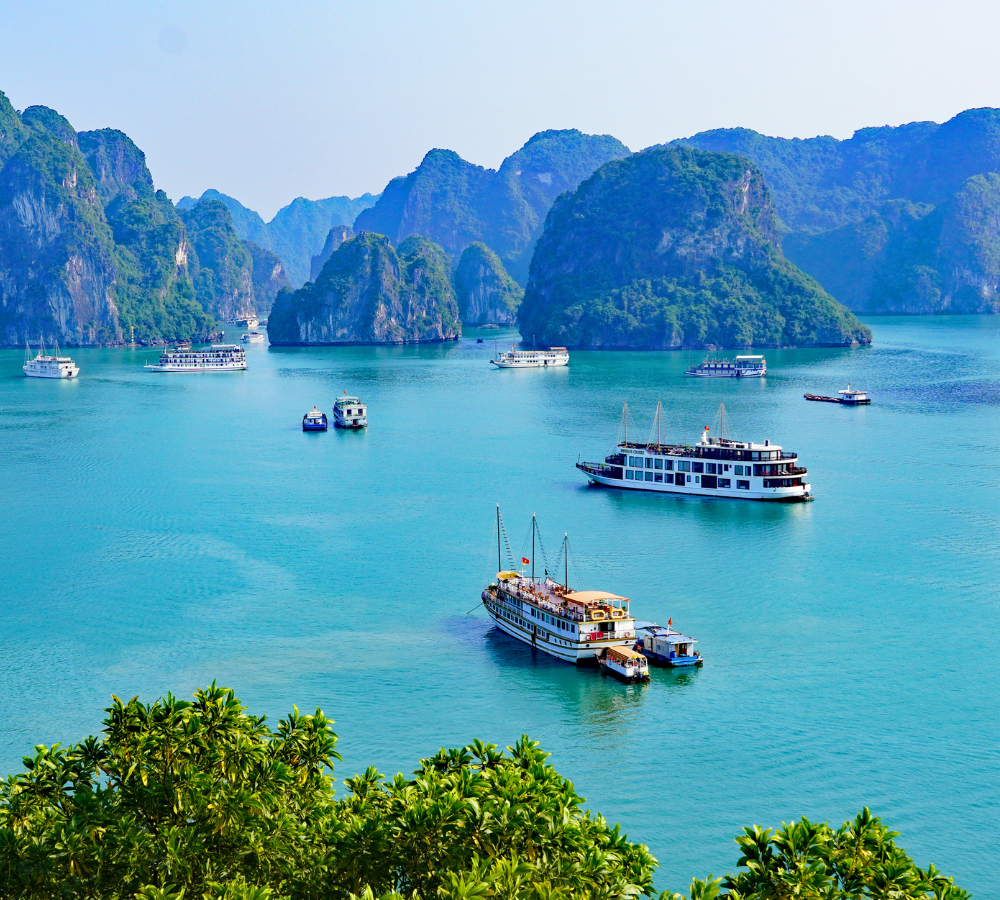Location. This beautiful capital strategically lies at the center of the triangular basin of the Red River. With around 3.5 million people, and an area of 920 square km, Hanoi is now the country’s center of economy, politics, culture, and society.

Natural conditions
Hanoi is famous for numerous rivers, lakes, and mountains alongside and in the surroundings. Scattered around are places of sight-seeing, which are so much attractive thanks to green lands full of streams, rivers, and mountain, such as Tam Dao, Con Son, Kiep Bac, etc. Hanoi is also well known for typical tropical seasoned place of South East Asia with four seasons: fresh, green and cool in Spring, a bit hot in Summer, fine in Autumn, and cold in Winter. Yet the most interesting thing is that all those take place in most sites of the capital. “Leisuring around the rivers in the suburbs or walking down the green mountains like Soc Temple in Soc Mount, Ve Linh Mount, Phuc Tuong Mount, etc, in autumn brings in such a great feeling. Believe me, you will taste the cool and fresh air as if the most delicious desert after such a busy time”, said a busy trader during her stay in Hanoi.
History
Before being named “Hanoi” as present, the capital had had several names throughout history. In 1010, Ly Thai To, the first ruler of the Ly Dynasty, moved the capital of Đại Việt (the Great Viet) to the site of the Đại La Citadel. Claiming to have seen a dragon ascending the Red River, he renamed it Thăng Long (Ascending Dragon) – a name still used poetically to this day with the belief that this was good omen of the country’s future. It remained the capital of Vietnam until 1397, when the capital was moved to Thanh Hoa, also known as Tây Đô (Western Capital). Thăng Long then became Đông Đô (Eastern Capital). King Minh Mang, under the Nguyen Dynasty, has laid the name “Hanoi” on the capital since 1831. This means “a city lying Between Rivers or River Interior”, which are Red and Day rivers. Hanoi became the capital of Vietnam when North and South Vietnam were reunited on July 2, 1976.
Many historians reckon that the city was established more than 1,500 years ago. Therefore, with the length of living, Hanoi is very rich of cultural, historical and traditional values.
Historical Places to visit
Within the “River Interior City”, there are a number of historical and beautiful places to get by. Mentioning about Hanoi, what comes first to tourists’ mind is the ever first historical University of the capital and also the nation – Van Mieu – Quoc Tu Giam (Translated as “The Literature Temple”). Besides its foremost meaning, Van Mieu is also the place to worship Confucius, setting doctor steles. Youngsters and youth always come here to pray for success by touching the rock tortoises’ head before any examinations, cause it is believed to be very sacred.
Since Vietnam is a Buddhism-oriented nation, its capital has been the Buddhism center for centuries. As a result, it is not surprising that there are as many as about 600 temples and pagodas in Hanoi. For Buddhist tourists, among many great pagodas, Tran Quoc Pagoda should be the first to pay a visit. It is not only the oldest one among those 600, (6 century years old), but also one of the most gorgeous and sacred. The second that is worth visiting is Mot Cot Pagoda (One-Pillar pagoda), another symbol of the capital. Its special architecture is similar to a lotus on the top of water.

Located near the two symbolic pagodas and right in the middle of the capital it is the historical Lake – Hoan Kiem Lake (Lake of Returned Sword), and Ngoc Son Temple with 100% natural beauty. Related to the Lake, Vietnam has a classic story telling about King Le Loi after winning over Minh invader, returned the magic Sword to the Tortoise down in the Lake. Since then, the Lake was named “Hoan Kiem”. It is more surprising that up to now, the historical Tortoise still sometimes appear up the Lake surface for a moment.
As for Catholics coming to Hanoi, there are also great Churches to come for praying and/or visiting. From 19th century, many Catholic churches were built in here. The biggest one is Cathedral. And Cua Bac church is a beautiful original typical French architect.
As you may have found out, Hanoi is more an antique and peaceful city than a modern one. This might be seen quite clearly when you take a walk around the 36 Old Quarter. This is a typical characteristic of Hanoi with small old streets, tube houses which still remain their shape from 19th century. Additionally, the beauty of Hanoi in the past is also found in the ancient citadel, right nearby.
Historical places that worth to pay a visit cannot be without Ba Dinh Square, the political area where President Ho Chi Minh read the Independent Declaration on the September 2nd, 1945. As famous as this is the House of Parliament, Presidential Palace, President Ho Chi Minh Mausoleum, etc.
To know more about Vietnam in general and Hanoi in particular, both in terms of history, tourists should spend one or two days on visiting the nation’s Ethnology, Military, History, Ho Chi Minh,… museums. These will open a huge detailed picture of this antique and beautiful historical city.
Culture
Talking about Hanoi’s culture, there must be a long time to complete the story. The initial Hanoi’s famous cultural thing is a series of traditional handicraft villages, such as Bat Trang ceramic and pottery village, Hang Bac silver-making street, Ngu Xa bronze-making, Phu Do noodle-making, Yen Phu incense, and Ngoc Ha flower, and Dong Ho picture villages. All of them have existed for centuries, and are still famous for 99% hand-made and 100% nature-originated products.
Hanoians are extremely good at making and tasting food. They have so many delicacies, for example, Banh cuon (steamed rice roll), Cha ca La Vong (La Vong grilled fish), Pho (noodle) with chicken or beef, Nem (spring roll), and so on. it can be said that this is the most attractive thing for foreigners to come and feel a “special Hanoi through Hanoi specialties”.
Adding more to Hanoi’s culture, kinds of arts play very impotant role. Hanoi’s famous culture also lies in Folk performances, which are Water Puppet, Cheo, Tuong and A Dao… (a traditional kind of music performances).
Sight-seeing
Besides plentiful cultural relics, Hanoi boasts many scenes of beauty. The most popular ones in Hanoi are peaceful lakes. Standing around all the city’s lakes are great and high green trees with large shadows on sunny days. Also, they are sources of inspiration for artists. The famous Hoan Kiem Lake (mentioned above), West Lake, Truc Bach, Bay Mau Lake, etc., are the undeniable green, fresh, and peaceful beauties of the capital. Lots of songs and poems have recommended their beauty from time to time, season to season. “West Lake in the Autumn afternoon, peaceful flat water surface from far far away is so much appealing…”, those beautiful popular song words are always ever bear in mind by Hanoians as time goes by.
Water Park near West Lake is another side of sight-seeing places with all colorful and playful water games to play. This is really suitable for children. But it is strongly suggested that they should always be accompanied by their parents when playing strong-feeling games there!
A green and peaceful Hanoi, a fast-growing hospitable city with great tourism potentials, is now open and warmly welcome friends from all over the world.
Tours in and around Hanoi city are available at all duration and price levels from different travel agencies, in which short-length city tours (one day or half a day) and day tours from Hanoi are most popular among tourists thanks to its low prices and flexible time arrangements. Hanoi is a mix of busy modern life and sustainable values preserved for generations. As such, this capital city has become extremely attractive to tourists especially with Culture and History tours.


















